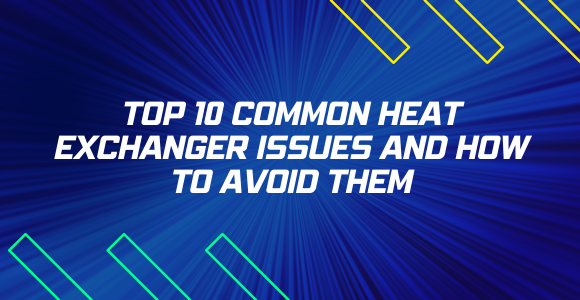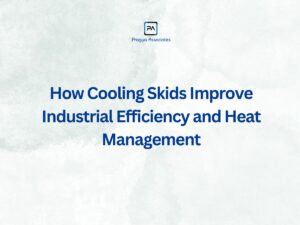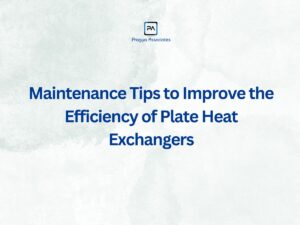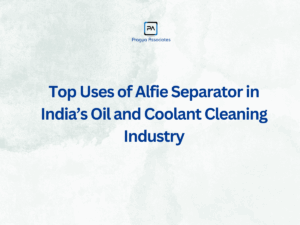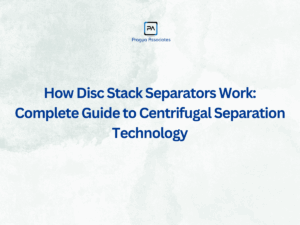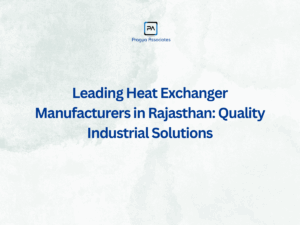Heat exchangers are extremely important devices used to transfer heat between two fluids without them mixing. They are widely used in various industries for effective heat transfer. These include manufacturing, HVAC systems, food processing, and power plants. However, like any mechanical system, heat exchangers can also have problems over time.
In this blog, we will explore the top 10 common heat exchanger issues. We’ll also look into how to avoid these issues to ensure optimal performance and a long lifespan.
1. Fouling and Scaling
When unwanted substances like dirt, debris, or minerals accumulate on the heat exchanger surfaces, it’s referred to as fouling. This layer acts as an insulating barrier, reducing heat transfer efficiency. One type of fouling is scaling, which occurs when minerals like calcium and magnesium accumulate on surfaces.
How to Avoid:
Fouling and scaling can be avoided with regular cleaning and maintenance. Also, the use of filters or chemical treatments can reduce build-up. Above all, if your fluids contain a lot of contaminants, make sure to choose heat exchangers made of non-fouling materials.
Read More: Overcome Fouling Challenges In Plate Heat Exchangers With Effective Practices
2. Leaks
When fluid inside a heat exchanger flows out, it causes a leak. They may also occur as a result of outside contaminants getting into the system. Leaks can lead to a loss of fluid, reduced efficiency, and potential damage to other equipment.
How to Avoid
To prevent leaks, regularly inspect the seals, gaskets, and welds for signs of wear or damage. Also, make sure that the heat exchanger is installed correctly and that the operating pressure and temperature are within safe limits. To reduce the risk of leaks, always choose high-quality heat exchangers with durable seals.
3. Corrosion
Corrosion occurs when heat exchanger materials, such as aluminium or copper, react with internal fluids or the environment. This reaction causes the metal to weaken and break down, resulting in holes, cracks, or even complete failure over time.
How to Avoid
To avoid corrosion, select a heat exchanger made of corrosion-resistant materials like stainless steel or titanium. Regularly inspect the system for signs of corrosion and replace worn-out parts. Another way to stop corrosion is to use sacrificial anodes or protective coatings.
4. Overheating
Overheating occurs when the heat exchanger cannot efficiently transfer heat. As a result, the temperature inside the system rises beyond safe levels, damaging the exchanger and leading to system failure.
How to Avoid
To prevent overheating, ensure that the system has good temperature monitoring and control. Check that the heat exchanger is the right size for your needs. Furthermore, it ensures that it can handle the flow rates and temperature differences required. Perform routine maintenance to keep the flow steady and prevent fouling, which also helps avoid overheating.
5. Wrong Sizing
Incorrectly sizing a heat exchanger for a specific application can lead to underperformance. If it’s too small, it won’t transfer enough heat, while if it’s too large, it can cause inefficiency and higher operational costs.
How to Avoid
Always consult experts or manufacturers when selecting a heat exchanger. Calculate the system’s required heat load, flow rates, and temperature differences accurately. It will help you select the correct size. Choosing the right model will improve your efficiency and prevent unnecessary energy use.
6. Air in the System
Air trapped inside the heat exchanger can also affect the fluid flow. As a result, the rate of heat transfer decreases, resulting in uneven heating or cooling. It can lead to inefficiency and wear on the system.
How to Avoid
Ensure proper ventilation is used during the installation of the heat exchanger to remove any trapped air. Regularly check for signs of air pockets in the system and use air vents to release trapped air. Also, ensure that the system is properly sealed to prevent air from entering during operation.
7. Vibration
Vibration in heat exchangers is often caused by uneven flow or external factors like pumps and fans. Over time, these vibrations create stress and wear on components, which can lead to cracks, loose connections, or even broken parts. They can also damage or fail essential components, such as pipes, gaskets, or the heat exchanger itself, ultimately reducing the system’s efficiency and lifespan.
How to Avoid
Proper installation is key to minimizing vibrations. Ensure that the system is supported correctly and that all components are aligned. Use vibration dampeners and conduct regular inspections for signs of stress. These steps can help prevent any kind of long-term damage.
8. Poor Flow Distribution
Uneven fluid distribution inside the heat exchanger can result in underutilized parts, leading to reduced efficiency. This issue often arises due to improper design or poor maintenance.
How to Avoid
Regular maintenance to clean the internal surfaces and ensure smooth fluid flow is crucial. Opt for heat exchangers with designs that promote even flow distribution, such as multi-pass or optimized plate configurations.
9. Gasket Failure
In plate heat exchangers, the gaskets play a critical role in sealing the fluids inside. Over time, these gaskets can wear out due to constant pressure, temperature changes, or chemical exposure. As a result, they may crack, degrade, or fail, which can lead to leaks or contamination between the fluids.
How to Avoid
Check gaskets regularly and replace them when they show signs of wear. Always use high-quality gaskets made from materials compatible with your fluids. Most importantly, when replacing a gasket, strictly follow the manufacturer’s guidelines.
10. Thermal Shock
Thermal shock occurs when the heat exchanger’s temperature suddenly changes. It can cause stress and cracks in the material. It usually occurs when the heat exchanger experiences rapid temperature changes.
How to Avoid
Gradually increase or decrease the temperature to avoid sudden changes. Install temperature controls and monitoring systems to prevent extreme conditions that could lead to thermal shock. Ensure that the materials used in the heat exchanger are designed to handle these temperature fluctuations.
Conclusion
Understanding the frequent issues that haunt heat exchangers makes it possible to take steps to avert them. Proper sizing, quality products, and regular maintenance should ensure the longevity and efficiency of your heat exchangers. Don’t let any of these issues occur, as they would lead you to costly repairs or, worse, system failure. Keep it proactive and ensure that your heat exchanger continues working at its best for years to come.

